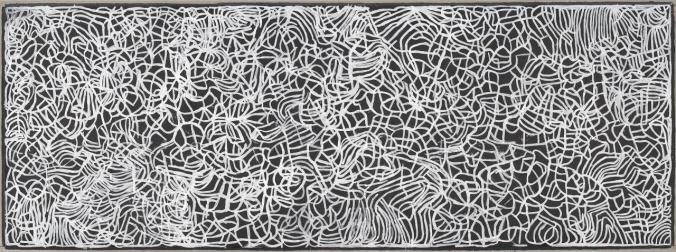
Emily Kam kngwarray,Anwerlarr anganenty(Big yam Dreaming)1995
Who’s Afraid of Colour? is an exhibition presenting over 200 contemporary artworks by 118 Indigenous Australian women artists together, celebrates the diversity and daring of their work. The art work including painting, sculpture, drawing, ceramics, glass, video, photography, jewellery, textiles, design and installation. Emily Kam Kngwarray, Judy Watson and Yvonne Koolmatrie who represented Australia at the Venice Biennale in 1997 in a landmark moment which acknowledged the importance of Indigenous women’s art practice on an international scale are all featured in this exhibition. The exhibition not only show the traditional art practice but also show the contemporary art challenged by the artists.
Emily Kam Kngwarray ” was an Australian Aboriginal artist from the Utopia community in the Northern Territory. She is one of the most prominent and successful artists in the history of contemporary indigenous Australian art.” The art work of Emily Kam Kngwarray, named Anwerlarr anganenty (Big yam Dreaming) in 1995 is a typical one in the exhibition. This paint has only tangled lines which were neither notation nor narrative, but visual music with mass appeal. The yam plant was an important source of food for the Aboriginal people of the desert. So Kngwarrary cannot live without the yam in the daily life. As a part of life,Yam is especially to her as her middle name “kam” means the yellow flower of the yam that grows above the ground. Kngwarreye’s initial artistic training was as a traditional indigenous woman, preparing and using designs for women’s ceremonies. Actually most of the woman indigenous artists are inspired like Kngwarreye. Most of their works are reflect the authentic life of the community. Their design inspired by their daily life and directly express their emotion. So the indigenous design is a very import cultural carrier need to be handed down through generation of the aboriginal community. The good design always come from real life and the value of the indigenous design need a rising. “ the use of the traditional design is essential to maintain cultural and spiritual integrity of an indigenous community and that this is sufficient reason to grant rights of control over traditional design to the community.”[1] Here culture means a traditional way of life ,communal institutions, languages, and distinct forms of cultural expression “refers to the culture of a community as a whole.”[2]
The exhibition shows not only the traditional practice of art work and the new development of it but also shows a culture of the community of the indigenous. Through this exhibition, we are not just attracted by the amazing art work, we also need to concentrate on the culture behind them. We could also feel that the attitude of the indigenous towards to the life. Most of the work without reference to sacred law or narrative: they are simply exercises in line and rhythm but is a direct reflection of their authentic life.
[1] Kimberlee Weatherall, “Culture, Autonomy and Djulibinyamurr: Individual and Community in the Construction of Rights to Traditional Designs,” The Modern Law Review, Vol. 64, No. 2, 2001, 215- 242.
[2] Ibid.